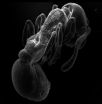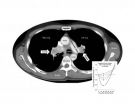(Press-News.org) HOUSTON -- (Feb. 6, 2013) -- A new Rice University-led study finds the real estate mantra "location, location, location" may also explain one of Earth's enduring climate mysteries. The study suggests that Earth's repeated flip-flopping between greenhouse and icehouse states over the past 500 million years may have been driven by the episodic flare-up of volcanoes at key locations where enormous amounts of carbon dioxide are poised for release into the atmosphere.
"We found that Earth's continents serve as enormous 'carbonate capacitors,'" said Rice's Cin-Ty Lee, the lead author of the study in this month's GeoSphere. "Continents store massive amounts of carbon dioxide in sedimentary carbonates like limestone and marble, and it appears that these reservoirs are tapped from time to time by volcanoes, which release large amounts of carbon dioxide into the atmosphere."
Lee said as much as 44 percent of carbonates by weight is carbon dioxide. Under most circumstances that carbon stays locked inside Earth's rigid continental crust.
"One process that can release carbon dioxide from these carbonates is interaction with magma," he said. "But that rarely happens on Earth today because most volcanoes are located on island arcs, tectonic plate boundaries that don't contain continental crust."
Earth's climate continually cycles between greenhouse and icehouse states, which each last on timescales of 10 million to 100 million years. Icehouse states -- like the one Earth has been in for the past 50 million years -- are marked by ice at the poles and periods of glacial activity. By contrast, the warmer greenhouse states are marked by increased carbon dioxide in the atmosphere and by an ice-free surface, even at the poles. The last greenhouse period lasted about 50 million to 70 million years and spanned the late Cretaceous, when dinosaurs roamed, and the early Paleogene, when mammals began to diversify.
Lee and colleagues found that the planet's greenhouse-icehouse oscillations are a natural consequence of plate tectonics. The research showed that tectonic activity drives an episodic flare-up of volcanoes along continental arcs, particularly during periods when oceans are forming and continents are breaking apart. The continental arc volcanoes that arise during these periods are located on the edges of continents, and the magma that rises through the volcanoes releases enormous quantities of carbon dioxide as it passes through layers of carbonates in the continental crust.
Lee, professor of Earth science at Rice, led the four-year study, which was co-authored by three Rice faculty members and additional colleagues at the University of Tokyo, the University of British Columbia, the California Institute of Technology, Texas A&M University and Pomona College.
Lee said the study breaks with conventional theories about greenhouse and icehouse periods.
"The standard view of the greenhouse state is that you draw carbon dioxide from the deep Earth interior by a combination of more activity along the mid-ocean ridges -- where tectonic plates spread -- and massive breakouts of lava called 'large igneous provinces,'" Lee said. "Though both of these would produce more carbon dioxide, it is not clear if these processes alone could sustain the atmospheric carbon dioxide that we find in the fossil record during past greenhouses."
Lee is a petrologist and geochemist whose research interests include the formation and evolution of continents as well as the connections between deep Earth and its oceans and atmosphere..
Lee said the conclusions in the study developed over several years, but the initial idea of the research dates to an informal chalkboard-only seminar at Rice in 2008. The talk was given by Rice oceanographer and study co-author Jerry Dickens, a paleoclimate expert; Lee and Rice geodynamicist Adrian Lenardic, another co-author, were in the audience.
"Jerry was talking about seawater in the Cretaceous, and he mentioned that 93.5 million years ago there was a mass extinction of deepwater organisms that coincided with a global marine anoxic event -- that is, the deep oceans became starved of oxygen," Lee said. "Jerry was talking about the impact of anoxic conditions on the biogeochemical cycles of trace metals in the ocean, but I don't remember much else that he said that day because it had dawned on me that 93 million years ago was a very interesting time for North America. There was a huge flare-up of volcanism along the western margin of North America, and the peak of all this activity was 93 million years ago.
"I thought, 'Wow!'" Lee recalled. "I know coincidence doesn't mean causality, but it certainly got me thinking. I decided to look at whether the flare-up in volcanic activity that helped create the Sierra Nevada Mountains may also have affected Earth's climate."
Over the next two years, Lee developed the idea that continental-arc volcanoes could pump carbon dioxide into the atmosphere. One indicator was evidence from Mount Etna in Sicily, one of the few active continental-arc volcanoes in the world today. Etna produces large amounts of carbon dioxide, Lee said, so much that it is often considered an outlier in global averages of modern volcanic carbon dioxide production.
Tectonic and petrological evidence indicated that many Etna-like volcanoes existed during the Cretaceous greenhouse, Lee said. He and colleagues traced the likely areas of occurrence by looking for tungsten-rich minerals like scheelite, which are formed on the margins of volcanic magma chambers when magma reacts with carbonates. It wasn't easy; Lee spent an entire year pouring through World War II mining surveys from the western U.S. and Canada, for example.
"There is evidence to support our idea, both in the geological record and in geophysical models, the latter of which show plausibility," he said. For example, in a companion paper published last year in G-Cubed, Lenardic used numerical models that showed the opening and breakup of continents could change the nature of subduction zones, generating oscillations between continental- and island-arc dominated states.
Though the idea in the GeoSpheres study is still a theory, Lee said, it has some advantages over more established theories because it can explain how the same basic set of geophysical conditions could produce and sustain a greenhouse or an icehouse for many millions of years.
"The length of subduction zones and the number of arc volcanoes globally don't have to change," Lee said. "But the nature of the arcs themselves, whether they are continental or oceanic, does change. It is in the continental-arc stage that CO2 is released from an ever-growing reservoir of carbonates within the continents."
INFORMATION:
Rice co-authors include Dickens and Lenardic, both professors of Earth science; Rajdeep Dasgupta, assistant professor of Earth science; Bing Shen, postdoctoral research associate; Benjamin Slotnick, graduate student; and Kelley Liao, a graduate student who began work on the project as undergraduate. Additional co-authors include Yusuke Yokoyama of the University of Tokyo, Mark Jellinek of the University of British Columbia, Jade Star Lackey of Pomona College, Tapio Schneider of Caltech and Michael Tice of Texas A&M. The research was supported by the Packard Foundation, the Atmosphere and Ocean Research Institute at the University of Tokyo, the National Science Foundation and the Miller Institute at the University of California, Berkeley.
High-resolution IMAGES are available for download at:
http://eol.jsc.nasa.gov/sseop/images/EO/highres/ISS002/ISS002-E-8683.JPG
CAPTION: A new Rice University-led study examines whether continental-arc volcanoes like Mount Etna in Sicily may have produced high levels of carbon dioxide during long greenhouse periods in Earth's ancient past.
CREDIT: NASA
High-resolution IMAGES are available for download at:
http://news.rice.edu/wp-content/uploads/2013/02/0211-EARTH-fig-lg.jpg
CAPTION: This diagram illustrates how fluctuations between continental-arc states and island-arc states could lead to episodic deposition and purging of carbon dioxide in Earth's continental crust.
CREDIT: C. Lee/Rice University
High-resolution IMAGES are available for download at:
http://news.rice.edu/wp-content/uploads/2013/02/1009_LEE-lg.jpg
CAPTION: Cin-Ty Lee
CREDIT: Tommy LaVergne/Rice University
A copy of the GeoSphere paper is available at:
http://geosphere.geoscienceworld.org/content/9/1/21.abstract
Volcano location could be greenhouse-icehouse key
Study: Episodic purging of 'carbonate capacitor' drives long-term climate cycle
2013-02-07
ELSE PRESS RELEASES FROM THIS DATE:
Surgical procedure appears to improve outcomes after bleeding stroke
2013-02-07
A minimally invasive procedure to remove blood clots in brain tissue after hemorrhagic stroke appears safe and may also reduce long-term disability, according to late-breaking research presented at the American Stroke Association's International Stroke Conference 2013.
Of the hundreds of thousands of Americans who have intracerebral hemorrhages (ICH) each year, most are severely debilitated, said Daniel Hanley, M.D., lead author and professor of neurology at Johns Hopkins School of Medicine in Baltimore, Md.
ICH is the most common type of bleeding stroke. It occurs when ...
Southern diet could raise your risk of stroke
2013-02-07
Eating Southern-style foods may be linked to a higher risk of stroke, according to research presented at the American Stroke Association's International Stroke Conference 2013.
In the first large-scale study on the relationship between Southern foods and stroke, researchers characterized a Southern diet by a high intake of foods such as fried chicken, fried fish, fried potatoes, bacon, ham, liver and gizzards, and sugary drinks such as sweet tea. In addition to being high in fat, fried foods tend to be heavily salted.
"We've got three major factors working together in ...
Almost 8 percent of US stroke survivors may have suicidal thoughts
2013-02-07
Nearly one in 12 American stroke survivors may have contemplated suicide or wished themselves dead, according to a study presented at the American Stroke Association's International Stroke Conference 2013.
The proportion of stroke survivors who contemplated suicide was striking, compared with patients with other health conditions, said Amytis Towfighi, M.D., lead author of the study and an assistant professor of Clinical Neurology at the University of Southern California in Los Angeles and chair of the Department of Neurology at Rancho Los Amigos National Rehabilitation ...
Infant, child stroke survivors prone to seizures, epilepsy
2013-02-07
About one-third of American infants and children who suffer bleeding into brain tissue, may later have seizures and as many as 13 percent will develop epilepsy within two years, according to new research reported at the American Stroke Association's International Stroke Conference 2013.
Bleeding into brain tissue is a type of stroke called intracerebral hemorrhage (ICH). Each year, an estimated 6.4 newborns and children per every 100,000 in the United States suffer strokes. About half of the strokes are hemorrhagic, typically caused by rupturing of weakened or malformed ...
Some stroke patients whose life support is withdrawn may have achieved a less-than-ideal
2013-02-07
More than a third of patients who suffer a major bleeding in the brain and have their life support withdrawn might have eventually regained an acceptable level of functioning if life support had been sustained, suggests a new study presented at the American Stroke Association's International Stroke Conference 2013.
In the United States, 10 percent of the estimated 795,000 strokes each year are intracerebral hemorrhages (ICH). ICH is the most common type of bleeding stroke and it occurs when a weakened blood vessel inside the brain ruptures and leaks blood into surrounding ...
Magnetic map guides salmon home
2013-02-07
For sockeye salmon coming home after years spent at sea, a magnetic map is apparently responsible for their remarkable sense of direction. That's according to an analysis of data collected over 56 years and reported online on February 7 in Current Biology, a Cell Press publication.
"To find their way back home across thousands of kilometers of ocean, salmon imprint on the magnetic field that exists where they first enter the sea as juveniles," said Nathan Putman of Oregon State University. "Upon reaching maturity, they seek the coastal location with the same magnetic ...
For ant pupae, status means being heard
2013-02-07
AUDIO:
This is a recording of ant pupa sound.
Click here for more information.
For young ants at the pupal stage of life—caught between larva and adulthood—status is all about being heard. The findings, reported online on February 7 in Current Biology, a Cell Press publication, add to evidence that ants can communicate abstract information through sound in addition to chemical cues.
"One of the truly fascinating characteristics of social insects is their power of self-organization, ...
Researchers identify potential target for age-related cognitive decline
2013-02-07
As the elderly age, their ability to concentrate, reason, and recall facts tends to decline in part because their brains generate fewer new neurons than they did when they were younger. Now, researchers reporting in the February 7th issue of the Cell Press journal Cell Stem Cell have discovered a molecule that accumulates with age and inhibits the formation of new neurons. The finding might help scientists design therapies to prevent age-related cognitive decline.
The investigators identified the molecule, called Dickkopf-1 or Dkk1, in the brains of aged mice. By blocking ...
Reassuring evidence: Anticancer drug does not accelerate tumor growth after treatment ends
2013-02-07
Studies in animals have raised concerns that tumors may grow faster after the anticancer drug sunitinib is discontinued. But oncologists and physicists who collaborated to analyze data from the largest study of patients with kidney cancer convincingly demonstrate that such tumor acceleration does not occur in humans. The findings, publishing online on February 7th in the Cell Press journal Cell Reports, suggest that sunitinib does not cause lingering risks for patients after their treatment ends.
"We were able to demonstrate that this applied across all patients and that ...
Hopkins researchers uncover key to antidepressant response
2013-02-07
Through a series of investigations in mice and humans, Johns Hopkins researchers have identified a protein that appears to be the target of both antidepressant drugs and electroconvulsive therapy. Results of their experiments explain how these therapies likely work to relieve depression by stimulating stem cells in the brain to grow and mature. In addition, the researchers say, these experiments raise the possibility of predicting individual people's response to depression therapy, and fine-tuning treatment accordingly. Reports on separate aspects of the research were published ...
LAST 30 PRESS RELEASES:
Young adults commonly mix cannabis with nicotine and tobacco
Comprehensive review illuminates tau protein's dual nature in brain health, disease, and emerging psychiatric connections
Book prepares K-12 leaders for the next public health crisis
Storms in the Southern Ocean mitigates global warming
Seals on the move: Research reveals key data for offshore development and international ecology
Sports injuries sustained during your period might be more severe
World's first successful 2 Tbit/s free-space optical communication using small optical terminals mountable on satellites and HAPS
Can intimate relationships affect your heart? New study says ‘yes’
Scalable and healable gradient textiles for multi‑scenario radiative cooling via bicomponent blow spinning
Research shows informed traders never let a good climate crisis go to waste
Intelligent XGBoost framework enhances asphalt pavement skid resistance assessment
Dual-function biomaterials for postoperative osteosarcoma: Tumor suppression and bone regeneration
New framework reveals where transport emissions concentrate in Singapore
NTP-enhanced lattice oxygen activation in Ce-Co catalysts for low-temperature soot combustion
Synergistic interface engineering in Cu-Zn-Ce catalysts for efficient CO2 hydrogenation to methanol
COVID-19 leaves a lasting mark on the human brain
Scientists use ultrasound to soften and treat cancer tumors without damaging healthy tissue
Community swimming program for Black youth boosts skills, sense of belonging, study finds
Specific depressive symptoms in midlife linked to increased dementia risk
An ‘illuminating’ design sheds light on cholesterol
Who is more likely to get long COVID?
Study showcases resilience and rapid growth of “living rocks”
Naval Research Lab diver earns Office of Naval Research 2025 Sailor of the Year
New Mayo-led study establishes practical definition for rapidly progressive dementia
Fossil fuel industry’s “climate false solutions” reinforce its power and aggravate environmental injustice
Researchers reveal bias in a widely used measure of algorithm performance
Alcohol causes cancer. A study from IOCB Prague confirms damage to DNA and shows how cells defend against it
Hidden viruses in wastewater treatment may shape public health risks, study finds
Unlock the power of nature: how biomass can transform climate mitigation
Biochar reshapes hidden soil microbes that capture carbon dioxide in farmland
[Press-News.org] Volcano location could be greenhouse-icehouse keyStudy: Episodic purging of 'carbonate capacitor' drives long-term climate cycle




